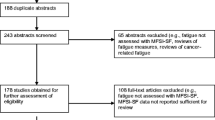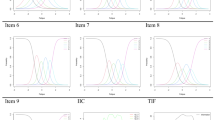Abstract
Fatigue is frequently reported by patients with mental illness. The multidimensional fatigue inventory (MFI-20) is a self-assessment instrument with 20 items including five dimensions of fatigue. The purpose of this study was to examine the test–retest reliability, internal consistency, convergent construct validity and feasibility of using MFI-20 in patients with schizophrenia spectrum disorders. Patients completed two self-assessment instruments, MFI-20 (n = 93) and Visual Analogue Scale (n = 79), twice within 1 week ±2 days. Fifty-three patients also rated the feasibility of responding to the MFI-20 with a Likert scale. The test–retest reliability and validity were analysed by using Spearman's correlations and internal consistency by calculating Cronbach's α. The test–retest showed a correlation between .66 and .91 for all subscales of MFI. The internal consistency was .92. The analysis of convergent construct validity showed a correlation of .68 (time 1) and .77 (time 2). No item was systematically identified as being difficult to answer.
Similar content being viewed by others
References
Alsén, P., Brink, E., Brändström, Y., Karlsson, B., & Persson, L.-O. (2010). Fatigue after myocardial infarction: Relationships with indices of emotional distress and sociodemographic and clinical variables. International Journal of Nursing Practice, 16, 326–334.
Björkqvist, K. (2012). Introduktion i vetenskapsteori och forskningsmetodik för beteendevetenskap [Introduction to theory of science and research method for behavioural science]. Lund: Studentlitteratur.
Bol, Y., Duits, A., Hupperts, R., Verlinden, I., & Verhey, F. (2010). The impact of fatigue on cognitive functioning in patients with multiple sclerosis. Clincal Rehabilitation, 24, 854–862.
Breukink, S. O., Strijbos, J. H., Koorn, M., Koёter, G. H., Breslin, E. H., & van der Schans, C. P. (1998). Relationship between fatigue and physiological variables in patients with chronic obstructive pulmonary disease. Respiratory Medicine, 92, 676–682.
Elbers, R. G., van Wegen, E. E. H., Verhoef, J., & Kwakkel, G. (2012). Reliability and structural validity of the multidimensional fatigue inventory (MFI) in patients with idiopathic Parkinson´s disease. Parkinsonism and Related Disorders, 18, 532–536.
Ericsson, A., & Mannerkorpi, K. (2007). Assessment of fatigue with fibromyalgia and chronic widespread pain. Reliability and validity of Swedish version of the MFI-20. Disability and Rehabilitation, 29, 1665–1670.
Fürst, C. J., & Åhsberg, E. (2001). Dimensions of fatigue during radiotherapy—An application of the multidimensional fatigue inventory. Supportive Care in Cancer, 9, 355–360.
Harrington, M. (2012). Neurobiological studies of fatigue. Progress in Neurobiology, 2, 93–105.
Hertzog, M. (2008). Considerations in determining sample size for pilot studies. Research in Nursing & Health, 31, 180–191.
Hunter, J., Marshall, J., Corcoran, K., Leeder, S., & Phelps, K. (2013). A positive concept of health-Interviews with patients and practitioners in an integrative medicine clinic. Complementary Therapies in Clinical Practice, 19, 197–203.
Krupp, L. B., Alvarez, L. A., Larocca, N. G., & Scheinberg, L. C. (1988). Fatigue in multiple sclerosis. Archives of Neurology, 45, 435–437.
Lee, K. A., Hicks, G., & Nino-Murcia, G. (1990). Validity and reliability of a scale to assess fatigue. Psychiatry Research, 36, 291–298.
Lin, J.-M. S., Brimmer, D. J., Maloney, E. M., Nyarko, E., BeLue, R., & Reeves, E. C. (2009). Further validation of the multidimensional fatigue inventory in a US adult population sample. Population Health Metrics, 7, 18.
Lundh Hagelin, C., Wengström, Y., Runesdotter, S., & Fürst, C. J. (2007). The psychometric properties of the Swedish multidimensional fatigue inventory MFI-20 in four different populations. Acta Oncologica, 46, 97–104.
Nater, U. M., Jones, J. F., Lin, J.-M., Maloney, E., Reeves, W. C., & Heim, C. (2010). Personality features and personality disorders in chronic fatigue syndrome: A population-based study. Psychotherapy and Psychosomatics, 79, 312–318.
Nix, G., Ryan, R., Manly, B., & Deci, E. (1999). Revitalization through self-regulation: The effects of autonomous and controlled motivation on happiness and vitality. Journal of Experimental Social Psychology, 35, 266–284.
Palmese, L., DeGeorge, P., Rattliff, J., Srihari, V., Wexler, B., Krystal, A., et al. (2011). Insomnia is frequent in schizophrenia and associated with night eating and obesity. Schizophrenia Research, 133, 238–243.
Schneider, R. (1998). Concurrent validity of the beck depressions inventory and the multidimensional fatigue inventory-20 in assessing fatigue among cancer patients. Psychological Reports, 82, 883–886.
Smets, E., Garssen, B., Bonke, B., & Haes, J. (1995). The multidimensional fatigue inventory (MFI) psychometric qualities of an instrument to assess fatigue. Journal of Psychosomatic Research, 39, 315–325.
Stepnowsky, C., Palau, J., Zamora, T., Ancoli-Israel, S., & Loredo, J. (2011). Fatigue in sleep apnea: The role of depressive symptoms and self-reported sleep quality. Sleep Medicine, 12, 832–837.
Streiner, D., & Norman, G. R. (2002). Health measurement scales a practical guide to their development and use. New York: Oxford Press.
Targum, S., Hassman, H., Pinho, M., & Fava, M. (2012). Development of a clinical impression scale for fatigue. Journal of Psychiatric Research, 46, 370–374.
Visser, M., & Smets, E. (1998). Fatigue, depression and quality of life in cancer patients: How are they related? Supportive Care in Cancer, 6, 101–108.
Conflict of interest
None of the authors declare any conflict of interests. All authors certify responsibility.
Author information
Authors and Affiliations
Corresponding author
Rights and permissions
About this article
Cite this article
Hedlund, L., Gyllensten, A.L. & Hansson, L. A Psychometric Study of the Multidimensional Fatigue Inventory to Assess Fatigue in Patients with Schizophrenia Spectrum Disorders. Community Ment Health J 51, 377–382 (2015). https://doi.org/10.1007/s10597-014-9746-3
Received:
Accepted:
Published:
Issue Date:
DOI: https://doi.org/10.1007/s10597-014-9746-3




